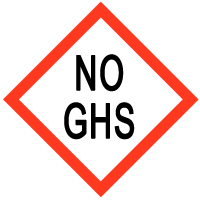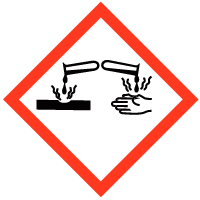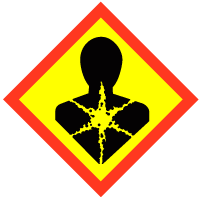Labeling
Name and Hazard
All containers of hazardous chemicals must be labeled with the chemical’s name and hazard(s). If a chemical has more than one hazard, it must be labeled with all its hazards. For example, ethanol is both flammable and an irritant, and must be labeled with both.
-
Initial Labeling
Inspect the labeling on incoming containers and replace damaged or semi-attached labels.
When transferring chemicals or preparing solutions in the lab, label each chemical container with the name and hazard warning(s). -
Hazards
All chemicals must be labeled with the Globally Harmonized System of Classification and Labelling of Chemicals (GHS) pictograms found on their original container or in Section 2 of the Safety Data Sheet (SDS).
It is acceptable to write the name of the GHS hazard as a substitute for the pictogram.
Special Considerations
-
Flammable Solvents in Refrigerators and Freezers
All refrigerator and freezer units used in laboratories must be marked as “SAFE FOR FLAMMABLE STORAGE” or “UNSAFE FOR FLAMMABLE STORAGE” on the exterior surface of the unit as appropriate. All cold rooms must be marked “UNSAFE FOR FLAMMABLE STORAGE.”
Flammable solvents may only be stored in household refrigerators and freezers if the Flash Point is above 100°F. All solvents stored this way must be labelled with “OK for Household Refrigerator Storage” and their Flash Point.
See Flammable Storage in Laboratory Refrigerators for more information. -
Alternate Methods for Labeling Multiple Small Containers
Legend Method
Label containers with abbreviated chemical name and hazard warnings.
- Post an abbreviation key in a visible location in the lab with complete chemical names and all its abbreviations.
- Document that employees are trained on the labeling system.
Box or Tray MethodPut containers in box or tray.
- Label tray with chemical name and hazard warnings.
- Containers can be removed from the box/tray without being labelled only if they are returned within the work-shift.
- Document that employees are trained on the labeling system.
-
Peroxide-Forming Chemicals
Peroxidizable chemicals are listed in APPENDIX G of the Chemical Hygiene Plan (PDF) and must be labeled with:
- Date Received
- Date Opened
- Date Tested
- Test Results
See Peroxide Formers for more information. -
Approval Required
The following labels are provided by EHS only following review and approval:
- Reactives: Air or water-reactive chemicals requiring special storage and handling conditions such as alkali metals.
- Toxic gases: CO, ammonia, ozone, and chlorine. Includes compressed gas cylinders and in-lab gas generators.
These labels can be requested via the EHS Safety Portal. -
Consumer Products
Anything available over the counter to the general public is exempt from labeling requirements if it has already been labeled by the manufacturer. This includes consumer products such as cans of spray paint or turpentine.
-
Stationary Containers
Stationary process containers such as tanks may be identified with signs, placards, process sheets, batch tickets or other written materials instead of permanently affixed labels. The sign or placard must convey the same information that a container label would, and must be visible to employees throughout the work shift.
-
Portable Containers
Portable containers used to transfer hazardous chemicals from labeled containers are exempt from labeling requirements if:
- The container is intended for use and control by the person who transferred the chemical.
- The transfer and use occur within the same work shift.
However, it is recommended to attach a temporary label to the container that includes the chemical name and hazards. -
Secondary Containers
The contents of secondary containers must be identifiable. If the secondary container blocks the view of the chemical’s label, an additional label should be posted on the secondary container.
-
Biological and Radiation Hazards
Refer to the Biosafety and Security Manual (PDF) and Radiation Safety Manual (PDF).
Also see section 3.4.1 of the Chemical Hygiene Plan (PDF)
Label Usage
| Label Name | Image | Usage |
|---|---|---|
|
Oxidizer |
Flame Over Circle |
GHS pictogram indicates the following hazards:
Use on secondary containers if this GHS hazard is indicated on chemical's original container or Safety Data Sheet. |
|
Toxic |
Skull and Crossbones |
GHS pictogram indicates the following hazards:
Use on secondary containers if this GHS hazard is indicated on chemical's original container or Safety Data Sheet. |
|
Caustic |
Corroding material on hand and metal |
GHS pictogram indicates the following hazards:
Use on secondary containers if this GHS hazard is indicated on chemical's original container or Safety Data Sheet. |
|
Irritant |
Exclamation Mark |
GHS pictogram indicates the following hazards:
Use on secondary containers if this GHS hazard is indicated on chemical's original container or Safety Data Sheet. |
|
Flammable |
Flame |
GHS pictogram indicates the following hazards:
Use on secondary containers if this GHS hazard is indicated on chemical's original container or Safety Data Sheet. |
|
Health Hazard |
Silhouette of a person with a starburst on the chest |
GHS pictogram indicates the following hazards:
Use on secondary containers if this GHS hazard is indicated on chemical's original container or Safety Data Sheet. |
|
Carcinogen |
Silhouette of a person with a starburst on the chest - yellow background |
Optional use instead of standard (white background) health hazard pictogram, for labs wishing to specify that carcinogenicity is the chemical's health hazard. |
|
Gas Cylinder |
Gas Cylinder |
GHS pictogram indicates the following hazards:
|
|
Explosive |
Exploding Bomb |
GHS pictogram indicates the following hazards:
Requires review by EHS. |
|
Environment |
Dead tree and fish |
GHS pictogram indicates the following hazards:
Optional use on secondary containers if this GHS hazard is found on chemical's original container or Safety Data Sheet. |
|
Biohazard |
 |
Use on secondary containers to indicate biosafety level 2 or 3 organisms, tissues, or other biological material risk. |
|
No GHS |
 |
Use on secondary containers with no GHS hazards indicated on the chemical's original container or Safety Data Sheet, such as deionized water. |
|
Peroxide Former |
 |
Label peroxide forming chemicals with date received, date opened, date tested, and results of annual peroxide testing. See Peroxide Formers |
|
Acetone |
 |
Use on secondary containers of acetone, such as benchtop bottles or sample vials. |
|
Ethanol |
 |
Use on secondary containers of ethanol, such as benchtop bottles or sample vials. |
|
Isopropanol |
 |
Use on secondary containers of isopropanol, such as benchtop bottles or sample vials. Peroxide test dates and results should be recorded annually. |
|
Reactive |
 |
Use for air or water-reactive chemicals requiring special storage and handling conditions such as alkali metals. Requires review by EHS. |
|
Toxic Gas |
 |
Use for toxic gases such as carbon monoxide, phosphine, or nitric oxide. Requires review by EHS. |
|
Lab Use Only (not food related) |
 |
Use on household and other equipment typically used outside of lab settings. Required before sending to surplus. |
|
Lab Use Only (food related) |
 |
Use on microwaves, blenders, and other equipment typically used for food preparation outside of lab settings. Required before sending to surplus. |
|
Food for Lab Use Only |
 |
Use on any food inside lab areas. All food inside lab areas must be designated for use in research. |
|
Flammable Solvent OK for Refrigerator |
 |
Label flammable solvents okay for household refrigerator storage only if the flash point is above 100°F. See Flammable Storage in Laboratory Refrigerators |
|
Tray |
 |
Label boxes or trays containing multiple small chemical containers, where labeling individual containers is infeasible. |
Obtaining Labels
Free label stocks are maintained by EHS in the following locations.
| Building | Location/Contact Person |
|---|---|
| Biomedical Physical Sciences | Corridor leading to the loading dock (outside 1104) |
| Bio Engineering | Workroom 3040 |
| Chemistry | Stockroom (sub-basement) |
| Engineering | Outside ECE Supply Room 3234 |
| Eng Research Complex | Mail Room |
| Food Science | Mail Room (2nd floor, to the right of the elevator) |
| Giltner Hall | Mail room 106 |
| ISTB | Loading bay 1312 |
| Life Science | Contact Core Facilities Officer Heather DeFeijter-Rupp |
| Michigan Biotech Institute | Central hallway across from B134 |
| Packaging | Contact Lab Manager Aaron Walworth |
| Plant Biology | Mail Room 142 |
| Plant and Soil Science | Plant Biology Mail Room 142 |
| Veterinary Medical Center | Contact Vet Med Safety Officer |
| Veterinary Diagnostic Laboratory | Contact Vet Med Safety Officer |
If label stocks have run out of any label type, email EHS at chemsafe@msu.edu and more will be delivered.
Labs without access to label stocks can request labels via campus mail through the EHS Safety Portal Label Request Form.
Printable Resources for Laboratories
Proper Labeling for Containers of Hazardous Chemicals Posting (PDF)
Printable 8.5 x 11" posting for use in laboratory covers basic chemical labeling requirements, peroxide former requirements, and alternate labeling method for multiple small containers
Self-Print Templates (Sharepoint)
Templates for labs to print their own commonly used labels for small containers, large containers, storage areas, instruments.











